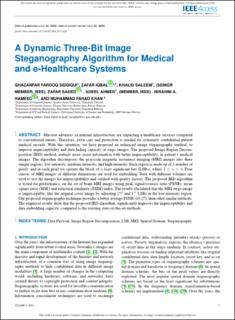| dc.contributor.author | Siddiqui, Ghazanfar Farooq | |
| dc.contributor.author | Iqbal, Zafar | |
| dc.contributor.author | Saleem, Khalid | |
| dc.contributor.author | Saeed, Zafar | |
| dc.contributor.author | Ahmed, Adeel | |
| dc.contributor.author | Hameed, Ibrahim A. | |
| dc.contributor.author | Khan, Muhammad Fahad | |
| dc.date.accessioned | 2020-10-12T12:00:40Z | |
| dc.date.available | 2020-10-12T12:00:40Z | |
| dc.date.created | 2020-10-07T22:42:58Z | |
| dc.date.issued | 2020 | |
| dc.identifier.issn | 2169-3536 | |
| dc.identifier.uri | https://hdl.handle.net/11250/2682246 | |
| dc.description.abstract | Massive advances in internet infrastructure are impacting e-healthcare services compared to conventional means. Therefore, extra care and protection is needed for extremely confidential patient medical records. With this intention, we have proposed an enhanced image steganography method, to improve imperceptibility and data hiding capacity of stego images. The proposed Image Region Decomposition (IRD) method, embeds more secret information with better imperceptibility, in patient’s medical images. The algorithm decomposes the grayscale magnetic resonance imaging (MRI) images into three unique regions: low-intensity, medium-intensity, and high-intensity. Each region is made up of k number of pixels, and in each pixel we operate the block of n least significant bits (LSBs), where 1 ≤ n ≤ 3. Four classes of MRI images of different dimensions are used for embedding. Data with different volumes are used to test the images for imperceptibility and verified with quality factors. The proposed IRD algorithm is tested for performance, on the set of brain MRI images using peak signal-to-noise ratio (PSNR), mean square error (MSE) and structural similarity (SSIM) index. The results elucidated that the MRI stego image is imperceptible, like the original cover image by adjusting 2nd and 1st LSBs in the low-intensity region. Our proposed steganography technique provides a better average PSNR (49.27), than other similar methods. The empirical results show that the proposed IRD algorithm, significantly improves the imperceptibility and data embedding capacity, compared to the existing state-of-the-art methods. | en_US |
| dc.language.iso | eng | en_US |
| dc.publisher | IEEE | en_US |
| dc.relation.uri | https://ieeexplore.ieee.org/document/9211478/authors#authors | |
| dc.rights | Navngivelse 4.0 Internasjonal | * |
| dc.rights.uri | http://creativecommons.org/licenses/by/4.0/deed.no | * |
| dc.title | A Dynamic Three-Bit Image Steganography Algorithm for Medical and e-Healthcare Systems | en_US |
| dc.type | Peer reviewed | en_US |
| dc.type | Journal article | en_US |
| dc.description.version | publishedVersion | en_US |
| dc.source.journal | IEEE Access | en_US |
| dc.identifier.doi | 10.1109/ACCESS.2020.3028315 | |
| dc.identifier.cristin | 1838067 | |
| dc.description.localcode | This work is licensed under a Creative Commons Attribution 4.0 License. For more information, see https://creativecommons.org/licenses/by/4.0/ | en_US |
| cristin.ispublished | true | |
| cristin.fulltext | original | |
| cristin.qualitycode | 1 | |

